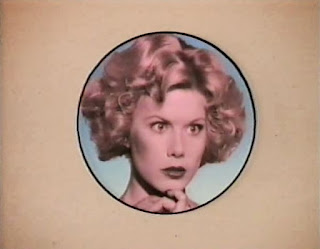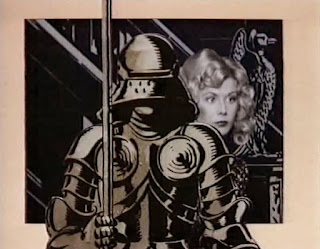Classic TV: Jane (1982) and Jane in the Desert (1984)
Jane was the curvaceous comic strip heroine who helped to keep the British end up during World War II. She was the creation of cartoonist Norman Pett, who produced her adventures in serial form in the Daily Mirror newspaper from 1932 until 1959, originally as Jane's Journal, The Diary of a Bright Young Thing. But it was during the Second World War that Jane reached the peak of her popularity.
Jane's main distinguishing feature was her remarkable ability to keep losing her clothes. This usually happened at the most inopportune moments and no Jane comic strip was complete without some kind of revealing wardrobe malfunction. But the shedding of her clothes was almost always accidental, meaning that Jane could just about maintain a sense of innocence among the comic strip's sauciness.
 |
| Glynis Barber as Jane |
This added to her appeal for a generation of soldiers far from home as a perfect "English rose", combining charm, innocence, a plucky spirit of adventure and some alluring, and usually accidental, nudity. In the war years, Jane was often involved in spy adventures, where she outwitted enemy spies and saboteurs with the aid of her faithful, if ironically named, dachshund called Fritz.
Although incredibly popular in Britain during the war, Jane proved to be too risqué for more conservative American tastes and her attempts to break in to the US market were unsuccessful. American cartoonists were aware of her, however, and she does seem to have inspired imitators on the other side of the Atlantic, including Milton Caniff's Male Call.
Jane made her feature film debut in 1949 in a low budget cash-in film called The Adventures of Jane, starring Christabel Leighton-Porter, who had been Norman Pett's physical model for the character.
 |
| Comic strip style panels from the first series of Jane |
But Jane's most successful screen adventures came much later, when her exploits were turned into a BBC TV series in the 1980s. The TV version was made in a tongue-in-cheek style in 10 minute episodes, and is notable for its combination of comic strip and live action. The series eschewed real settings and instead placed the actors into comic strip backgrounds with the use of chroma key visual effects to replicate the look and feel of the original cartoon strip.
The series was written by Mervyn Haisman, produced by Ian Keill and directed by Andrew Gosling. Keill and Gosling had both previously worked on Eric Idle's parody Rutland Weekend Television and on Neil Innes's The Innes Book of Records. Neil Innes would also provide the title song and incidental music for Jane.
In the TV version Jane was played by Glynis Barber, who made her an appealing and (reasonably) wholesome heroine. The first series, simply titled Jane, was first broadcast in nightly ten minute episodes in August 1982, and featured several of the recurring characters from the original comic strip version. These included Jane's boss the Colonel, her pet dog Fritz, her boyfriend Georgie Porgie and her regular antagonist, German spy Lola Pagola.
 |
| Jane in hiding at Ghastly Grange |
The story finds our heroine working for the crusty Colonel (Robin Bailey) when the pair are sent to Ghastly Grange, a country house on the south coast of England. While there, Jane tangles with enemy spy Lola Pagola (Suzanne Danielle) and uncovers a plot to bring a German invasion force into Britain by sea.
Jane's investigations lead her to be mistakenly identified as a German spy herself and arrested. But she eventually turns the tables and saves the day, with the help of Fritz and the house's lugubrious butler, the appropriately named Tombs, played by the comic Max Wall.
As in the comic strip, Jane is continually losing her clothes along the way, snagging her dress on a fence or a tree or being strip-searched by German spies. Unlike in the comic strip version, Jane is never actually nude, this version being made for a family audience. Instead, her wardrobe disasters mostly mean being reduced to wearing her underwear.
It's hard to say exactly how much this series is a recreation of the Jane comic strip and how much it's a parody - it's probably most accurate to say that it's both. The use of real actors put into comic strip backgrounds, complete with framing panels, is surprisingly successful and gives this series an unexpected degree of charm and certainly of visual distinctiveness. The 1940s-style theme song and incidental music, sung as well as composed by Neil Innes, also help to set an appropriate light and nostalgic tone.
 |
| Jane and the Commander (Frank Thornton) |
Jane returned for a second series, Jane in the Desert, in September 1984. Glynis Barber returned as Jane, as did Max Wall as the butler Tombs. In this story, Jane accompanies a naval commander (Frank Thornton) on a mission to the Middle East. There they rescue a kidnapped scientist and uncover a German plot to steal the formula for a tremendous new British invention - the creation of a super fuel derived from camel dung.
Jane in the Desert also features John Bird and John Savident as German agents and Fiona Hendley as Lola Pagola's sister Pola, but the most entertaining performance is from Frank Thornton (probably best known as Captain Peacock in the sitcom Are You Being Served?).
The mixture of live actors and comic strip backgrounds works just as well here as in the first series and both contain plenty of humour and mild innuendo. Jane doesn't lose her clothes quite so often in Jane in the Desert, so that may disappointment fans of Glynis Barber, although it does end with a genuine flash of nudity unique in the series (and it's all Churchill's fault).
Both Jane and Jane in the Desert are minor visual triumphs. Designer Graham McCallum won the BAFTA Television Award for Best Graphics in 1983, jointly for both Jane and the BBC's Gulliver in Lilliput. McCallum won again, together with John Kennedy, for the second series Jane in the Desert in 1985.
 |
| Glynis Barber filming against bluescreen |
Jane and Jane in the Desert were both shown again in 45 minute versions, edited together from the individual episodes. These lose the impact of the cliff-hanger episode endings and so don't work quite as well as the originals. You might also argue that a little of this sort of thing goes a long way and 10-15 minutes is about right, whereas 45 minutes is a bit of a stretch.
While Jane and Jane in the Desert are fun and nostalgic trifles, the makers had almost certainly exhausted the possibilities of this premise by the end of the second series and so probably called it a day at the right time.
Glynis Barber had already had a recurring role in the sci-fi series Blake's 7 when she was cast in the lead role in Jane. After this she went on to what is probably her best remembered role, in the ITV crime series Dempsey and Makepeace, opposite her future husband Michael Brandon.
A number of popular wartime and pre-war British heroes were being disinterred for film and TV in the 1980s, with varying degrees of seriousness, so Jane is a little unexpected, although not unique. These ranged from the slightly tongue-in-cheek, as with the Southern TV series Dick Barton: Special Agent and Robert Powell as Richard Hannay in Thames TV's Hannay, to the more humorous 1986 film Biggles and the outright spoofery of the 1983 Bulldog Drummond comedy Bullshot, with Alan Shearman as "Bullshot Crummond".
Jane transferred to the big screen in 1988 in a very unwise attempt at a live action film version without the comic strip backgrounds, Jane and the Lost City, which was again written by Mervyn Haisman. Kirsten Hughes starred as Jane, while Robin Bailey was again cast as the British colonel and the comedian Jasper Carrot played assorted German agents. According to Haisman, Glynis Barber was sought for the lead role, but was unavailable.
Unfortunately, Jane and Jane in the Desert haven't been officially released on DVD, but home recordings of the TV broadcasts have been uploaded to YouTube.
Jane
Year: 1982
Genre: Comedy
Country: UK
Episodes: 5 x 10 mins
Cast Glynis Barber (Jane), Robin Bailey (Colonel Henry), Max Wall (Tombs), Suzanne Danielle (Lola Pagola), Dean Allen (Georgie Porgie), John Rapley (Professor Donner), Clive Mantle (Private Smith), Leonard Trolley (Major Dunlightly), Nancy Nevinson (Colonel's wife), Lionel Taylor (General), Derek Ware (Chemist), Alan Mason (Sentry), Jimmy Mac (Porter), Arthur Nightingale (George), Arnold Locke (Bert), Bob Danvers Walker (voice)
Written by Mervyn Haisman, based on the Daily Mirror strip cartoon by Norman Pett Director Andrew Gosling Producer Ian Keill Graphic Designer Graham McCallum Illustrations Paul Birkbeck Music written and sung by Neil Innes
Production company/Original network BBC
Jane in the Desert
Year: 1984
Genre: Comedy
Country: UK
Episodes: 5 x 10 mins
Cast Glynis Barber (Jane), Frank Thornton (Commander), Max Wall (Tombs), Fiona Hendley (Pola Pagola), John Bird (Casper Cutler), John Savident (Boris Badinov), Bob Todd (Professor Crankshaft), John Quayle (Freddy), Howard Lang (Churchill), Bob Danvers Walker (voice)
Written by Mervyn Haisman, based on the Daily Mirror strip cartoon Jane by Norman Pett Director Andrew Gosling Producer Ian Keill Lighting director Derek Slee Studio designer Jim Grant Graphic design Graham McCallum, John Kennedy Visual effects designer Steve Drewitt Animator John Cousen Video effects Dave Chapman Editor Malcolm Warner Costume designer Rupert Jarvis
Production company/Original network BBC

Comments
Post a Comment